1 Introduction
In the ERP users market, large enterprises often have a multitude of assorted business
applications, with each having different business transformation and IT requirements. For
example, application requirements for Engineering, Manufacturing, Service &
Maintenance, Sales & Marketing, and Finance within the Aerospace & Defense
Industry are vastly different from that within other market verticals such as Electronics,
Process, Automotive, and Utilities. Even within the same industry, requirements vary
between enterprises. As a result, functional gaps often exist between the ERP package and
an enterprise’s business process.
While many of the ERP software vendors have incorporated vertical-specific
functionality to close these functional gaps, I have yet to see an off-the-shelf,
standalone ERP system that addresses ALL business requirements. And hypothetically, even
if all business requirements were able to be addressed by a single ERP system today, there
is always a requirement for future enhancements to existing functionality.
2 The Business Problem
- Industry verticals & geographies have different business requirements
- Competitive Advantage resides in Information Systems
- ERP systems address the common denominator across industries
- Processes across verticals addressed by variety of software components
- Legacies do not disappear overnight - some transition, some stay
- Solutions for business needs can evolve over time
- Advances in technology impact business process execution
- Solution sets by vertical - paradigm shift leading to "Best of Breed"
3 Method to Enhance Functionality
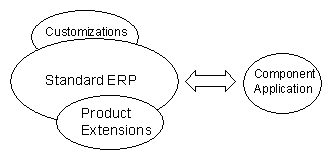
A common method used in the past to enhance functionality has been to modify the ERP
packages through customization. However, this has never been a sensible approach as it
defeats the underlying principle of buying commercial software solutions. A more pragmatic
method to close functional gaps is to select one ERP package to act as an enterprise
backbone, with specialized and more powerful software solutions integrated into the
backbone to address specific business requirements.
4 Impact of Best-of-Breed Solution on the IS Organization
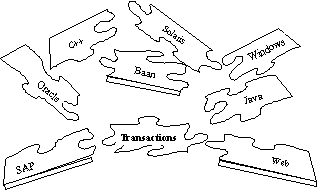
- IS organizations have to architect a solution with several components
- Cross functional business process & data flows across softwares require seamless
integration of components
- Release management for solution deployment can be stressful
- Standards have to be employed for successful integration
- Newer and upgraded skill sets are required
- Complexity of maintenance and support increases exponentially with the number of
components
5 Elements of a Component Architecture Solution
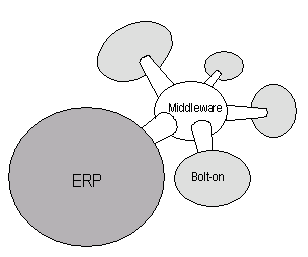
ERP Backbone System
At the heart of a component architecture solution is an ERP system, such as Baan,
to act as a backbone. The backbone is the primary information system and acts as a
repository and communication line between all the specialized Bolt-on applications.
Bolt-on applications
Bolt-on applications are software which perform specialized functions not generally
available within the ERP package. They could also substitute existing ERP functions to
provide a more powerful functional offering. Bolt-on applications can be classified as:
- Industry Specific Bolt-on applications
- Generic Bolt-on applications
- Specialized in-house packages developed by the customer (including legacy applications)
Middleware for Integration’s
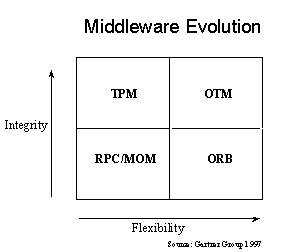
Middleware plays a significant role in the realization of an seamless integrated
solution. Middleware is often used to engage two software solutions in an integrated
fashion such that they can address a cross-functional business need, where a business
scenario may extend beyond the boundaries of one software package to another. The
integration techniques and middleware to be employed to achieve this have to be sound. In
addition, it must provide the enterprise with the ability to upgrade any of their
integrated software solution components without a major effort and time investment.
Several Middleware standards have emerged, with two standards that are quite prominent
today:
- Object Management Group’s CORBA standard
- Microsoft’s DCOM Standard
Middleware software’s that comply with the above standards are available in the
marketplace for integration of applications.
6 Integration Methods
To illustrate the various methods available for integrating an ERP system with
bolt-on applications, the Baan ERP software will be used as an example.
ASCII Integration
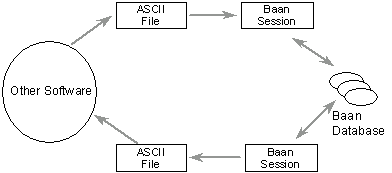
- Low cost
- Accepted by most software
- Mapping required
- Customizations "freeze" the record format
- Can be used for complicated application logic
Exchange Tool Integration
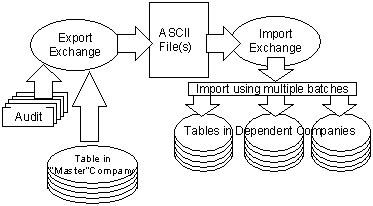
- Low cost
- Accepted by most software
- Mapping required
- Flexible format
- Not for complicated application logic
- Used for multi-site data replication
- Baan v offers electronic publish / subscribe mechanism
EDI Integration
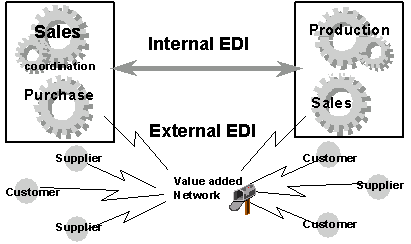
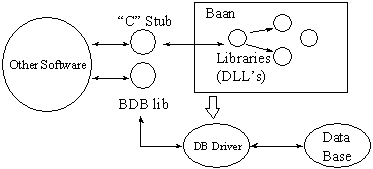
DDL Integration
- Fast
- Reliable
- Application logic resides in Baan
- Direct database reads/writes via Baan database drivers
- Limited error reporting
- Baan can also funtion as a client using API’s (Vertex)
BDB / SQL Calls
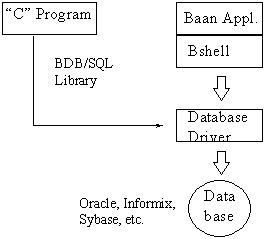
DDC Integration

- Communication with data collection devices
- Baan provides "C" libraries to vendors to develop the DDC driver
- Extensive transaction/error logging
- Function servers can be generated
- Works on-line and off-line (batch)
- DDC server is a Baan session
- Present in Baan V but can be replaced with Corba type interface
Orbix Integration
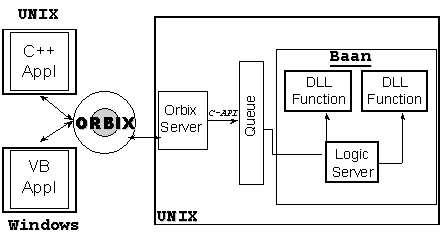
OLE Integration
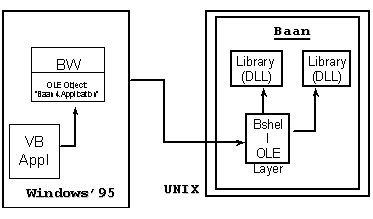
- Uses the BW Interface
- For integrations with applications such as Microsoft Products
Direct Database Integration
- Direct access to the database is supported by Oracle, Informix, etc.
- Assumes no interaction with the Baan Shell
- Viable for "Read-only" mode operations
- Writes to database conflict with "referential integrity"
- Writes to database conflict with "business rules"
- Can be used for data replication / data warehousing
- Quick response times for "Read-only" mode operations
7 Scope of Integration Services
Today, many IT service providers are able to address the consulting requirements
for most software solutions, as long as they are used in a single-mode and standalone
fashion. However, many providers lack the expertise and knowledge to assist in the
integration of a seamless enterprise-wide solution. IT service providers must possess more
than just ERP implementation skills, but expertise in the various bolt-ons and
middlewares. Therefore, Integration Services will be involved in providing customers with
the following services.
Application Integration Consulting
Application Integration Consulting is a specialized skill which provide
identification and understanding of integration points between Baan and bolt-on
applications. Supplemented by industry-specific knowledge, this consulting service assists
clients in the building of cross-functional process flows with different package solutions
to create one seamless system.
An example of an Application Integration Consultant skill-set would be the ability to
consult on the integration between Baan and the i2 solution for customers in the
automotive industry. Within this vertical, the ability to manage the supply chain is a
very critical process that requires the use of both packages.
Technical Integration Consulting
Technical Integration Consulting is another specialized skill which provides
customer organizations with the know-how and expertise regarding the technical aspects
involved in the evaluation and utilization of Middleware products. A Technical Integration
Consultant must also be able to construct the integration architecture, based on the work
performed by Application Integration Consultants. Whilst the focus for the Application
Integration Consultant is the application interaction and the process flows, the Technical
Integration Consultant approaches the entire integration from a systems viewpoint and
delivers the integrated solution.
Project Management Services
As with any project-based services, Project Management will be required to plan,
manage, and execute Integration Services. As Software Integration is often a sub-project
within a larger ERP implementation, the Integration Project Managers will fulfill their
roles under the direction of the overall Program Management.
In addition to general project management skills, an Integration Project Manager will
require skills and knowledge in the difference elements within a component architecture
environment, as well as the respective resources to realize their integration. The role of
the Integration P.M. is further complicated by the fact that Integration Services often
sits on the critical path of the overall ERP implementation. Therefore, an Integration
P.M. not only has responsibility of the on-time delivery of the integration project, but
has direct influence on the outcome of the entire implementation.
Product Integration Services
As Integration Services mature in the marketplace, opportunities will arise to
create standardized component architectures packages for the various vertical industries.
As some bolt-ons are more suitable for one vertical than others, a
"Best-Practice" approach can be taken to create standard, ready-to-use,
integration templates. These C Off The Shelf (COTS) applications will provide the
following benefits:
- Ability to buy integration objects for purposes of business transformation in a manner
similar to procuring COTS application packages.
- Reducing implementation lead times drastically as the integration of standard COTS
applications will no longer be a critical activity in implementation.
- Outsource the maintenance and upgrade of integration objects to an external vendor and
not manage this process in-house.
- All other advantages that in principle are the same as the reason for buying COTS
applications.
On the other hand, for the organization involved in the standardization of integration
between COTS applications, there will be several challenges :
- Ability to manage the multiple releases of different COTS applications and providing
realistic turn around times to customers in providing integration objects between these
applications.
- Realizing integration’s between applications in a manner by which it becomes a
truly "plug and play" environment without being too dependent on the
architecture of applications that are being integrated.
- Pioneering the concept of integrated objects between standard COTS packages not only to
their manufacturers but also to the market place in general.
- Resource related challenges from building core competence in these kind of activities to
continuously managing the ever changing advents in technologies related to
integration’s.
- All other challenges that come with the process of building a business that are related
to software manufacturing and distribution.
8 Future Trends
- Integrations will be the most important service for the next decade in enterprise
consulting
- Microsoft will emerge as a dominant player in the enterprise market
- CORBA and COM will co-exist
- "BOPS" and component softwares will be utilized by enterprises in a
heterogeneous environment
- Newer technologies will only enhance the requirement for integrations












